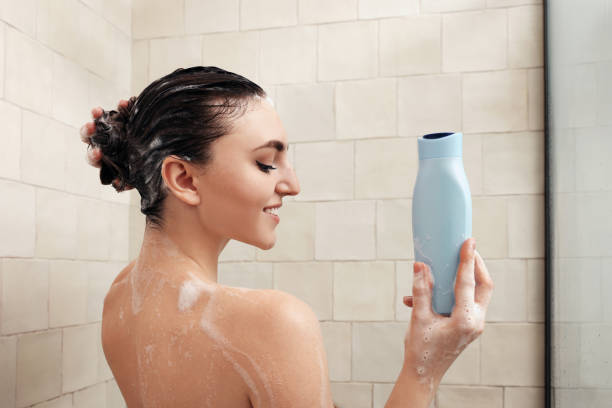
5 Essential Tips For Using Shampoo To Manage Dermatitis
Dealing with dermatitis, also known as eczema, on the scalp can be unpleasant and uncomfortable. However, with the proper shampoo selection and washing techniques, you can effectively manage scalp dermatitis. Shampoo is one of the most essential products for keeping dermatitis under control.
Here are five essential tips for using shampoo to care for irritated, inflamed skin on the scalp.
Tip 1 – Apply Shampoo Only to Scalp and Rinse Well
One important tip is to apply shampoo only to the scalp area affected by dermatitis and rinse it out thoroughly. Dermatitis can make skin extra dry and flaky. Over-applying shampoo to longer hair lengths risks removing too much natural oils. This leaves hair and skin feeling tight and dehydrated.
However, thoroughly rinsing out any cleanser residues from the scalp and hair is equally important. Any leftover product can continue irritating a sensitive scalp.
To properly cleanse the scalp, start by wetting hair thoroughly with lukewarm water. Then squeeze out a nickel to quarter-sized amount of gentle shampoo onto your fingertips. Massage this directly onto the flakes, scales or raised patches of irritated skin on the scalp. Avoid lathering shampoo all over hair lengths.
Instead, focus the cleansing massage in the areas where dermatitis occurs. Once the product has been worked in, rinse thoroughly with cool water to remove any traces of shampoo.
Making sure to apply shampoo for dermatitis UK judiciously to only problem areas of the scalp is a vital hygiene habit for managing dermatitis. It prevents over-drying other skin while still cleansing inflamed patches.
Thorough rinsing also removes any residues that could otherwise continue exacerbating the skin condition. By following these steps and using the appropriate shampoo for dermatitis available in the UK, the shampooing process causes minimal irritation.
Tip 2 – Massage Gently With Shampoo When Washing
Be extremely careful not to over-scrub or excessively rub the irritated scalp when washing the shampoo out. Dermatitis causes the skin to become inflamed, cracked and extra sensitive. Vigorous scrubbing can worsen this tenderness and cause the rash and flaking to spread or intensify.
However, it’s still essential to work shampoo thoroughly through the hair to remove oils, pollutants and microbes that could prolong or retrigger a flare-up.
The trick is to use light fingertips instead of fingernails to massage shampoo into a lather gently across the entire scalp. Rinse by pouring conditioner or water over the head with cupped hands, avoiding direct pressure or rubbing.
Taking time to soothe, not scrub, helps shampoo remove buildup without aggravating dermatitis. This balanced approach keeps the scalp clean while minimizing added trauma that holds recovery back.
Tip 3 – Condition Regularly to Supplement Moisture
Dermatitis patients must keep the scalp hydrated, as dry, flaky skin is more prone to irritation and cracking. Look for conditioners containing moisturizing proteins, ceramides and hydrating agents like glycerin—these work to replenish moisture levels after cleansing. Conditioning also forms a protective layer on hairs and follicles, guarding against future irritants that can trigger a flare.
Liberally apply conditioner from roots to ends after every shampoo, taking time to work it through gently. For severe dermatitis, try a leave-in conditioner or hair mask to provide extra nourishment. Coconut-based conditioners like SheaMoisture Coconut & Hibiscus work wonders for hydrating without residue.
Tip 4 – Consider Medicated or Therapeutic Shampoo
For moderate to severe dermatitis, over-the-counter shampoos may not provide enough anti-inflammatory or antifungal properties to control a flare-up. In these cases, a prescription medicated or therapeutic shampoo could offer more substantial relief.
Formulas containing ingredients like ketoconazole (Nizoral), selenium sulfide (Selsun Blue) or coal tar work to reduce itch, flaking and microbe overgrowth.
These clinical-strength cleansers are exclusively available by prescription from a dermatologist. They often combine antifungals and antibacterials with moisturizing properties to simultaneously fight dermatitis causes and calm symptoms.
Tip 5- Limit Shampooing When Scalp is Healed
Once a flare settles, it’s wise to scale back shampoo frequency even further to maintain healthy scalp hydration levels. Over-cleansing, especially with harsh formulas, strips too much oil leading to compensatory overproduction and exacerbated symptoms down the line. Limiting washes to 1-2 times weekly allows natural oils to replenish the protective acid mantle.
On non-wash days, rinse with water and reapply the conditioner. For very dry or easily irritated scalps, try co-washing using just conditioner to gently remove buildup without stripping natural fats. Listen to your scalp – if it feels balanced and flake-free between washes, stick to less frequent cleansing.
Conclusion
Making hydration a priority, avoiding harsh ingredients and limiting over-washing are vital tactics. Medicated shampoos quickly curb severe symptoms until the scalp heals. Home remedies deliver extra anti-itch and moisture-restoring benefits too.
Combining therapeutic shampoos with soothing natural solutions provides scalp dermatitis the customized TLC it requires. Adhering to a tailored regimen and listening closely to warning signs keeps the condition in remission long-term without significant disruptions. Empowering scalp health is within reach for dermatitis patients.
Related
Source: Vietnam Insider
